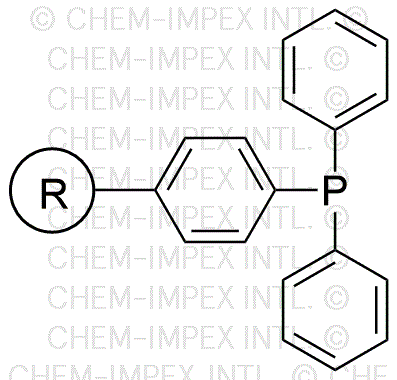Triphenylphosphine resin is widely utilized in research focused on:
- Organic Synthesis: This resin serves as a versatile reagent in various organic reactions, particularly in the synthesis of phosphonium salts and other organophosphorus compounds, enhancing reaction efficiency and yield.
- Solid-Phase Extraction: It is employed in the purification and isolation of organic compounds, allowing researchers to effectively separate desired products from complex mixtures, which is crucial in drug development and environmental analysis.
- Catalysis: The resin acts as a catalyst support in numerous reactions, providing a stable platform for catalytic processes, thus improving reaction rates and selectivity in pharmaceutical manufacturing.
- Bioconjugation: In biochemistry, it is used for attaching biomolecules to surfaces or other compounds, facilitating the development of targeted drug delivery systems and diagnostic tools.
- Polymer Chemistry: The resin is utilized in the synthesis of functionalized polymers, contributing to the development of advanced materials with specific properties for applications in electronics and coatings.
General Information
Properties
Safety and Regulations
Applications
Triphenylphosphine resin is widely utilized in research focused on:
- Organic Synthesis: This resin serves as a versatile reagent in various organic reactions, particularly in the synthesis of phosphonium salts and other organophosphorus compounds, enhancing reaction efficiency and yield.
- Solid-Phase Extraction: It is employed in the purification and isolation of organic compounds, allowing researchers to effectively separate desired products from complex mixtures, which is crucial in drug development and environmental analysis.
- Catalysis: The resin acts as a catalyst support in numerous reactions, providing a stable platform for catalytic processes, thus improving reaction rates and selectivity in pharmaceutical manufacturing.
- Bioconjugation: In biochemistry, it is used for attaching biomolecules to surfaces or other compounds, facilitating the development of targeted drug delivery systems and diagnostic tools.
- Polymer Chemistry: The resin is utilized in the synthesis of functionalized polymers, contributing to the development of advanced materials with specific properties for applications in electronics and coatings.
Documents
Safety Data Sheets (SDS)
The SDS provides comprehensive safety information on handling, storage, and disposal of the product.
Product Specification (PS)
The PS provides a comprehensive breakdown of the product’s properties, including chemical composition, physical state, purity, and storage requirements. It also details acceptable quality ranges and the product's intended applications.
Certificates of Analysis (COA)
Search for Certificates of Analysis (COA) by entering the products Lot Number. Lot and Batch Numbers can be found on a product’s label following the words ‘Lot’ or ‘Batch’.
Número de catálogo
Número de lote/lote
Certificates Of Origin (COO)
This COO confirms the country where the product was manufactured, and also details the materials and components used in it and whether it is derived from natural, synthetic, or other specific sources. This certificate may be required for customs, trade, and regulatory compliance.
Número de catálogo
Número de lote/lote
Safety Data Sheets (SDS)
The SDS provides comprehensive safety information on handling, storage, and disposal of the product.
DownloadProduct Specification (PS)
The PS provides a comprehensive breakdown of the product’s properties, including chemical composition, physical state, purity, and storage requirements. It also details acceptable quality ranges and the product's intended applications.
DownloadCertificates of Analysis (COA)
Search for Certificates of Analysis (COA) by entering the products Lot Number. Lot and Batch Numbers can be found on a product’s label following the words ‘Lot’ or ‘Batch’.
Número de catálogo
Número de lote/lote
Certificates Of Origin (COO)
This COO confirms the country where the product was manufactured, and also details the materials and components used in it and whether it is derived from natural, synthetic, or other specific sources. This certificate may be required for customs, trade, and regulatory compliance.


